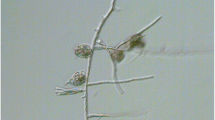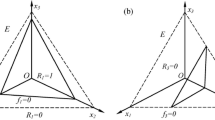Abstract
The objective of our study was to analyze the effects of temperature on the population dynamics of a three-species food web consisting of two prey bacteria (Pedobacter sp. and Acinetobacter johnsonii) and a protozoan predator (Tetrahymena pyriformis) as model organisms. We assessed the effects of temperature on the growth rates of all three species with the objective of developing a model with four differential equations based on the experimental data. The following hypotheses were tested at a theoretical level: Firstly, temperature changes can affect the dynamic behavior of a system by temperature-dependent parameters and interactions and secondly, food web response to temperature cannot be derived from the single species temperature response. The main outcome of the study is that temperature changes affect the parameter range where coexistence is possible within all three species. This has significant consequences on our ideas regarding the evaluation of effects of global warming.





Similar content being viewed by others
References
Caron DA, Davis PG, Madin LP, Sieburth JM (1982) Heterotrophic bacteria and bacterivorous protozoa in oceanic macro-aggregates. Science 218:795–797
Chase JM, Abrams PA, Grover JP, Diehl S, Chesson P, Holt RD, Richards SA, Nisbet RM, Case TJ (2002) The interaction between predation and competition: a review and synthesis. Ecol Lett 5:302–315
Clarke A (2006) Temperature and the metabolic theory of ecology. Funct Ecol 20:405–412
Davis AJ, Jenkinson LS, Lawton JH, Shorrocks B, Wood S (1998) Making mistakes when predicting shifts in species range in response to global warming. Nature 391:783–786
Durant JM, Hjermann DO, Ottersen G, Stenseth NC (2007) Climate and the match or mismatch between predator requirements and resource availability. Clim Res 33:271–283
Elliott AM (1973) Biology of Tetrahymena. Hutchinson & Rosi Inc, Dowden
Gächter E, Weisse T (2006) Local adaptation among geographically distant clones of the cosmopolitan freshwater ciliate Meseres corlissi. I. Temperature response. Aquat Microb Ecol 45:291–300
Hahn MW, Pockl M (2005) Ecotypes of planktonic Actinobacteria with identical 16S rRNA genes adapted to thermal niches in temperate, subtropical, and tropical freshwater habitats. Appl Environ Microbiol 71:766–773
Hall EK, Dzialowski AR, Stoxen SM, Cotner JB (2009) The effect of temperature on the coupling between phosphorus and growth in lacustrine bacterioplankton communities. Limnol Oceanogr 54:880–889
Harmon JP, Moran NA, Ives AR (2009) Species response to environmental change: impacts of food web interactions and evolution. Science 323:1347–1350
Hindmarsh AC (1983) ODEPACK, a systematized collection of ODE solvers. In: Stepleman RS et al (eds) Scientific computing. North Holland, Amsterdam, pp 55–64
Jessup CM, Kassen R, Forde SE, Kerr B, Buckling A, Rainey PB, Bohannan BJM (2004) Big questions, small worlds: microbial model systems in ecology. TREE 19:189–197
Jiang L, Morin PJ (2004) Temperature-dependent interactions explain unexpected responses to environmental warming in communities of competitors. J Anim Ecol 73:569–576
Joehnk KD, Huisman J, Sharples J, Sommeijer B, Visser PM, Stroom JM (2008) Summer heat waves promote blooms of harmful cyanobacteria. Global Change Biol 14:495–512
Kooijman S (2000) Dynamic energy and mass budgets in biological systems. Cambridge University Press, Cambridge
Krenek S, Berendonk TU, Petzoldt T (2011) Thermal performance curves of Paramecium caudatum: a model selection approach. Europ J Protistol 47:124–137
Maruyama F, Yamaguchi N, Kenzaka T, Tani K, Nasu M (2004) Simplified sample preparation using frame spotting method for direct counting of total bacteria by fluorescence microscopy. J Microbiol Methods 59:427–431
O’Neill RV, Goldstein RA, Shugart HH, Mankin JB (1972) Terrestrial ecosystem energy model. Eastern deciduous forest biome memo report Oak Ridge. The Environmental Sciences Division of the Oak Ridge National Laboratory
Paaijmans KP, Read AF, Thomas MB (2009) Understanding the link between malaria risk and climate. PNAS 106:13844–13849
Pernthaler J (2005) Predation on prokaryotes in the water column and its ecological implications. Nat Rev Microbiol 37:537–546
Petchey OL, McPhearson PT, Casey TM, Morin PJ (1999) Environmental warming alters food-web structure and ecosystem function. Nature 402:69–72
Pounds JA, Bustamante MR, Coloma LA, Consuegra JA, Fogden MPL, Foster PN, La Marca E, Masters KL, Merino-Viteri A, Puschendorf R, Ron SR, Sanchez-Azofeifa GA, Still CJ, Young BE (2006) Widespread amphibian extinctions from epidemic disease driven by global warming. Nature 439:161–167
R Development Core Team (2008) An introduction to R: notes on R, a programming environment for data analysis and graphics (electronic edition): http://www.r-project.org
Schoolfield RM, Sharpe PJH, Magnuson CE (1981) Nonlinear regression of biological temperature-dependent rate models based on absolute reaction-rate theory. J Theor Biol 88:719–731
Sharpe PJH, DeMichele DW (1977) Reaction kinetics of poikilotherm development. J Theor Biol 64:649–670
Simon EM, Nanney DL, Doerder FP (2007) The “Tetrahymena pyriformis” complex of cryptic species. Biodiv Conserv 17:365–380
Slater JV (1954) Temperature tolerance in Tetrahymena. Am Nat 88:168–171
Soetaert K, Herman PMJ (2009) A practical guide to ecological modelling. Using R as a simulation platform. Springer, New York 372 pp
Soetaert K, Petzoldt T, Setzer RW (2010) Solving differential equations in R: package deSolve. J Stat Softw 33(9):1–25, http://www.jstatsoft.org/v33/i09/
Sommer U, Lewandowska A (2011) Climate change and the phytoplankton spring bloom: warming and overwintering zooplankton have similar effects on phytoplankton. Global Change Biol 17:154–162. doi:10.1111/j.1365-2486.2010.02182.x
Spain JD (1982) BASIC microcomputer models in biology. Addison-Wesley, Reading
Stenseth NC (2010) The biological consequences of global change. Integr Zool 5:85–86
Stenseth NC, Mysterud A (2002) Climate, changing phenology, and other life history and traits: nonlinearity and match-mismatch to the environment. PNAS 99:13379–13381
Wake DB, Vredenburg VT (2008) Are we in the midst of the sixth mass extinction? A view from the world of amphibians. PNAS 105:11466–11473
Walther GR, Post E, Convey P, Menzel A, Parmesan C, Beebee TJC, Fromentin JM, Hoegh-Guldberg O, Bairlein F (2002) Ecological responses to recent climate change. Nature 416:389–395
Weitere M, Dahlmann J, Viergutz C, Arndt H (2008) Differential grazer-mediated effects of high summer temperatures on pico- and nanoplankton communities. Limnol Oceanogr 53:1–10
Winder M, Schindler DE (2004) Climate change uncouples trophic interactions in an aquatic ecosystem. Ecology 85:2100–2106
Acknowledgments
This study was supported by a grant from the German Research Foundation (DFG) to H. A. (AR 288/14-1, 2). We would like to thank all collaborators in the frame of the priority program AQUASHIFT of the DFG, especially we would like to thank Ulrich Sommer, Thomas Petzoldt, Otto Richter, Klaus Jürgens and Markus Weitere for co-operation and two anonymous reviewers for constructive criticism.
Author information
Authors and Affiliations
Corresponding author
Additional information
Communicated by U. Sommer.
Rights and permissions
About this article
Cite this article
Monsonís Nomdedeu, M., Willen, C., Schieffer, A. et al. Temperature-dependent ranges of coexistence in a model of a two-prey-one-predator microbial food web. Mar Biol 159, 2423–2430 (2012). https://doi.org/10.1007/s00227-012-1966-x
Received:
Accepted:
Published:
Issue Date:
DOI: https://doi.org/10.1007/s00227-012-1966-x




